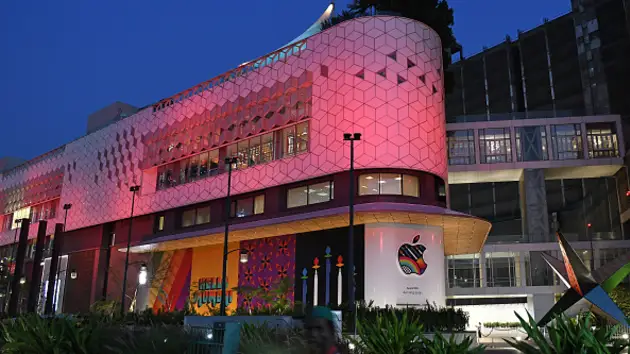Discover how Apple carbon-neutral stores in India are paving the way towards a sustainable future for the country and the world.
MUMBAI (India CSR): In the bustling streets of Mumbai, a new store caught the attention of the locals. It was the first Apple store in India, unlike any other. With a sleek and modern design, the store had caught the attention of many, but what really set it apart was its commitment to the environment.
The store was completely carbon neutral, with a dedicated solar array and zero reliance on fossil fuels. Apple had always been known for its innovative technology, but now they were taking their commitment to the environment to the next level.
The city itself also inspired the store’s design. The iconic black and yellow cabs that dotted the streets of Mumbai had been the inspiration for the store’s color scheme. It was a small touch, but it showed that Apple was committed to blending in with the local culture.
A few weeks later, another store opened in Delhi, completely carbon neutral and running on 100% renewable energy. It was located in a popular mall, but once again, Apple had managed to make it stand out. The store’s design was inspired by the city’s famous Red Fort, a monument that had stood for centuries.
Apple’s commitment to the environment didn’t stop with its stores. They had set a goal to become completely carbon neutral by 2030, and they were well on their way. They had already made strides in using recycled and renewable materials in their products, and they had set ambitious goals to use 100% recycled materials in key components by 2025.
For the people of India, the opening of the Apple stores was more than just the arrival of a new brand. It was a symbol of progress and a commitment to a sustainable future. As people walked through the sleek and modern stores, they couldn’t help but feel hopeful for what the future might hold. And for Apple, the message was clear – the earth won’t wait, and neither will they.
Apple has announced that it is committed to becoming carbon neutral by 2030. “Every Apple product will be made with clean energy and even more recycled and renewable materials. Because the earth won’t wait, and neither will we,” says a company note.
Apple said about 20 percent of the materials in products are made from recycled or renewable sources. “Our goal is to one day reach 100 percent, and to end our reliance on mining altogether. Where we continue to extract materials, we maintain the highest standards in our due diligence and respect for human rights. And we’re accelerating our work with new goals to use 100 percent recycled cobalt, tin, gold, and rare earth elements in key components by 2025.”
It adds, “One thing is clear: We’re closer than ever to the day you can hold your Apple device and be confident in the knowledge that it has net-zero carbon impact.”
“India has such a beautiful culture and an incredible energy, and we’re excited to build on our long-standing history,” Apple CEO Tim Cook said in a press release.
India’s smartphone market, however, has been dominated in recent years by Samsung and Chinese brands such as Xiaomi, with low-to-mid-tier priced devices finding support from customers in a price-sensitive market. Apple has very little market share in India.
But India is undergoing a “premiumification of market,” according to Neil Shah, the partner at Counterpoint Research. Smartphones priced above $400 now account for 10% of the total volumes of handsets shipped versus 4% before the pandemic, according to Shah. He said this category of smartphones accounts for 35% of total smartphone market revenue.
“Apple, as usual, has got the timing right on ‘peaking at the right time’ with its flagship store strategy to catalyze this trend in its favor,” Shah told.
India has a growing middle class, a young and “mobile first” population willing to pay more for phones, especially in Mumbai and Delhi, two of the country’s wealthiest cities and the location of the new Apple stores.
iPhone sales in focus
Apple’s India push offers the opportunity for the U.S. technology giant to boost revenue and iPhone sales near the levels seen in markets like the U.S. and China, analysts said.
Apple shipped about 6.5 million iPhones in India in 2022, compared to around 50 million each year in both the U.S. and China, according to Counterpoint Research. Shah said India “has the potential to reach that scale” in the coming years.
Shipments refer to the iPhones Apple sends to retailers but do not equal sales. However, it is an indicator of the demand for iPhones in a country.
Apple made $6 billion in revenue in the year through to March, growing 50%, Bloomberg reported on Monday, citing a person familiar with the matter.
Dan Ives, analyst at Wedbush Securities, said that could rise further over the next two years.
“Apple is now aggressively looking at India from both a production and retail expansion over the coming years that we believe will be a strategic poker move for Cupertino that could ramp annual revenue to $20 billion by 2025 in India,” Ives said in a note published Tuesday.
But it’s not just about selling iPhones. Apple’s strategy over the years has involved getting users locked into its suite of products including the Apple Watch and services like Apple Music.
“Apple can cross-sell other products such as Macs, Watch, AirPods, iPads and services to the growing iPhone user base maximizing the revenue opportunity,” Shah said.
Manufacturing push
For Apple, India also represents a key part of its manufacturing strategy for the future.
Apple began assembling its flagship iPhone 14 in India last year — the first time that the company has produced its latest device in the country, so close to its initial launch. Piyush Goyal, India’s minister of commerce and industry, said in January that Apple is aiming to make 25% of all of its iPhones in India.




















